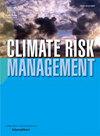气候和城市化在中国特大城市复合气象事件暴露中的作用
IF 5
2区 环境科学与生态学
Q1 ENVIRONMENTAL SCIENCES
引用次数: 0
摘要
复合降水和极端风速(CPWE)对城市地区的可持续发展构成了重大威胁。利用时空统计和归因分析方法,研究了中国9个城市群(每个城市群至少包含一个GDP超过万亿元的城市)CPWE的空间演化特征、潜在人口暴露风险和多维不平等。结果表明:城市群CPWE强度由东南向西北递减,轻度、中度、重度和极端暴露人群分别占总量的58%、28.3%、11.4%和2.3%;气候效应(58.29%±12.77%)是影响暴露风险的主要因素,其次是人群效应(32.15%±6.20%)和相互作用(9.55%±5.14%)。特别脆弱的珠江三角洲和长江三角洲的CPWE强度增幅超过0.015 /10a。观测到暴露风险每十年增加约0.62 × 104人,其中20%以上的人口面临严重或极端水平,主要是由于气候影响。CPWE暴露风险在各维度上存在显著不平等(空间自相关:Moran’s I = 0.3798, P = 0.001;基尼系数:0.08-0.5)。高风险和均衡发展地区(如珠三角、长三角)的不平等程度较低,而低风险和集中发展地区(如GPZ)的不平等程度较高。在低风险区和大部分高风险区,气候效应是主要影响因素。这些发现支持有针对性地实施适当的气候适应政策,以促进区域可持续发展。本文章由计算机程序翻译,如有差异,请以英文原文为准。
The role of climate and urbanization in compound meteorological event exposure in China’s megacities
Compound precipitation and wind speed extremes (CPWE) pose significant threats to the sustainable development of urban areas. This study investigated the spatial evolution characteristics, potential population exposure risk, and multidimensional inequality of CPWE within nine urban agglomerations in China, each containing at least one city with a GDP exceeding one trillion yuan, utilizing spatiotemporal statistics and attribution analysis. The results indicated that the intensity of CPWE in these urban agglomerations decreased from southeast to northwest, and the population exposed to mild, moderate, severe, and extreme levels accounted for 58 %, 28.3 %, 11.4 %, and 2.3 % of the total, respectively. Changes in exposure risk were driven by climate effect (58.29 % ± 12.77 %), followed by population (32.15 % ± 6.20 %) and interaction effect (9.55 % ± 5.14 %). Pearl River Delta (PRD) and Yangtze River Delta (YRD), identified as particularly vulnerable, experienced an increase in CPWE intensity exceeding 0.015 /10a. An increase of approximately 0.62 × 104 people per decade was observed for exposure risk, with over 20 % of the population facing severe or extreme levels, mainly due to the climate effect. CPWE exposure risk was significantly unequal across various dimensions (spatial autocorrelation: Moran’s I = 0.3798, P = 0.001; Gini coefficient: 0.08–0.5). Areas characterized by high-risk and balanced development (e.g., PRD, YRD) exhibited lower inequality, whereas regions featuring low-risk and concentrated development (e.g., GPZ) demonstrated higher inequality. The climate effect was the predominant influence in the low-risk areas as well as most high-risk areas. These findings support the targeted implementation of appropriate climate adaptation policies to promote regional sustainable development.
求助全文
通过发布文献求助,成功后即可免费获取论文全文。
去求助
来源期刊

Climate Risk Management
Earth and Planetary Sciences-Atmospheric Science
CiteScore
8.20
自引率
4.50%
发文量
76
审稿时长
30 weeks
期刊介绍:
Climate Risk Management publishes original scientific contributions, state-of-the-art reviews and reports of practical experience on the use of knowledge and information regarding the consequences of climate variability and climate change in decision and policy making on climate change responses from the near- to long-term.
The concept of climate risk management refers to activities and methods that are used by individuals, organizations, and institutions to facilitate climate-resilient decision-making. Its objective is to promote sustainable development by maximizing the beneficial impacts of climate change responses and minimizing negative impacts across the full spectrum of geographies and sectors that are potentially affected by the changing climate.
 求助内容:
求助内容: 应助结果提醒方式:
应助结果提醒方式:


